Do you also happen to possess one of those prized CorningWare dishes and don’t know their value? Well, you have come to the right place.
CorningWare has existed for more than 50 years and has produced quality kitchenware to this date. Their cookware has long been shopped by homemakers as “oven-to-table service.”
Pieces regarded to be “Vintage CorningWare” are those that were created before 1999, the year in which the brand was sold to World Kitchens. The most expensive items made by CorningWare today are designs that were made before the brand was sold.
Table of Contents
How Vintage CorningWare Came to be
There is a certain beauty in unexpected accidents. CorningWare dishes were also a result of such an accident. The person who was responsible for such as a business scientist named Dr. S. Donald Stookey of Corning Glass Works.
In 1953, Stokey inserted a piece of photosensitive glass into a furnace, but he inadvertently set the temperature to 900 degrees Fahrenheit rather than the desired 600 degrees. The end result was not what he had expected to happen.
Stokey had unintentionally found a form of ceramic glassware that was extraordinarily long-lasting, was able to withstand high levels of heat, was lighter than aluminium, harder than high-carbon steel, and many times as strong as glass.
The novel substance was given the name Pyroceram by the company. Pyroceram is a white glass-ceramic substance that is capable of withstanding a huge range of temperature variations.
After the discovery of such material, the company opted to make their cookware with the said material.
After five years, Corning’s applied kitchenware technology completely dominated the North American market with the launch of intricate and virtually indestructible pieces that could be moved directly from the freezer to the oven, and from the oven to the tabletop.
Corning developed numerous various patterns and types of Corning Ware (also sometimes written CorningWare and Corningware) over the course of forty years.
Products made by Corningware were considered to be cutting edge. Because they are made of the composite Pyroceram, which was developed during World War II, they are unaffected by high temperatures even if they are maintained for an extended period of time.
Corning’s casserole dishes and other bakeware were topped with the world-famous Pyrex glass lids that were manufactured by the firm.
However, Corning discontinued the production of Corningware made from pyroceram in the year 1998 after a change in ownership of the company, despite the material’s sustained popularity spanning several decades. In 2001, the company changed its name and rebranded itself with bakeware that had a stoneware motif.
To learn more about the production of CorningWare and how it came to be, check out The Vintage Company’s feature video on the company.
How Can You Tell If Corningware Is Vintage
CorningWare is highly sought after by collectors in the modern day due to the surge in popularity of mid-century modern furniture and decor that emerged in the decades following World War II, particularly in the 1960s.
Baby boomers, as well as Generation X, are getting into the hobby of collecting the things they had when they were growing up. CorningWare that is considered “classic” or “vintage” is now considered collectable, despite the fact that its allure to home cooks has never diminished.
We have some easy ways through which you can identify vintage corningware that you might possess. Just look for these vintage corning ware markings.
Check the Backstamp
When CorningWare was originally introduced to the market, it gained a significant amount of popularity almost immediately. Other manufacturers were motivated to produce knock-offs and imitations of CorningWare as a result of its enormous success.
Many of these imitations used patterns that were nearly indistinguishable from those found on genuine Corningware. When looking at the piece, it is difficult to tell if it was made by CorningWare or not.
At a glance, you can easily be fooled so to ensure an item is a real thing, turn it over and look at the back stamp on the underside.
The majority of the cookware that was manufactured by Corning prior to 1998 is marked with the name “Corning Ware,” but shortly before that year, the company started using the spelling “Corningware,” as is explained on the excellent non-commercial website Corelle Corner, which is geared toward collectors.
After the sale of Corning to World Kitchens, the original glass-ceramic cookware continued to be made under the spelling “Corningware” for another four years before it was finally retired.
You can check out Shane T. Wingerd’s blog in which he shares different labels that can be found on vintage CroningWare cookware.
Look at the Pattern
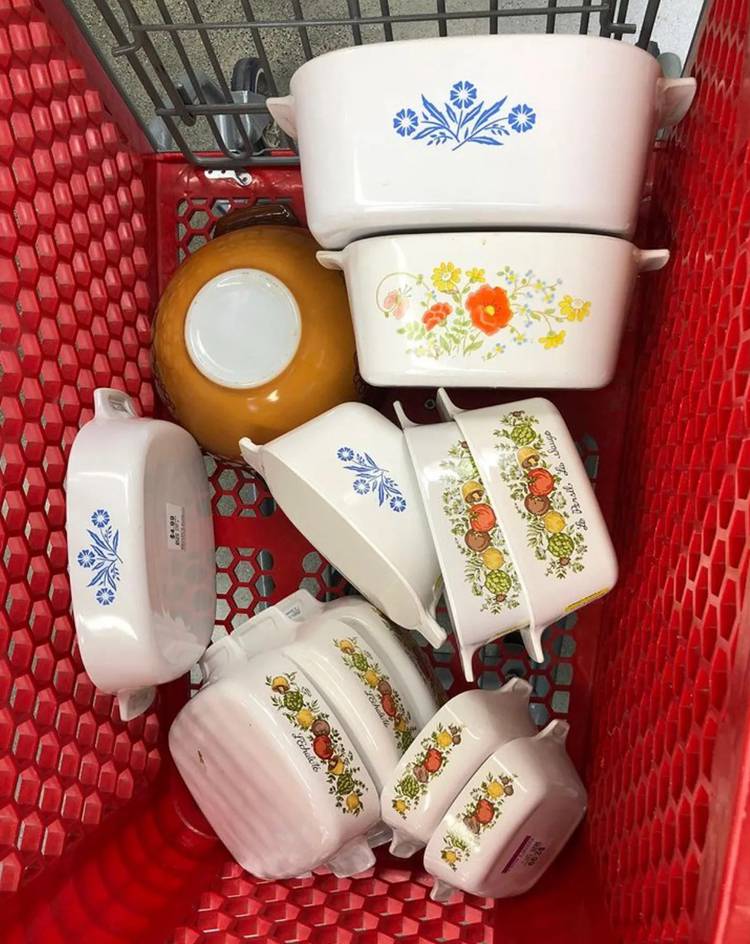
CorningWare is famous for the patterns that it produces, and the pattern that is on your piece can help you determine whether or not it is vintage.
The first design that was produced by CorningWare was a three-cornflower motif, and it was often blue in colour when it was applied to a white background.
While other patterns were only produced for limited amounts of time at various points in history, this one was continuously manufactured over the course of many years.
Check out the section on famous and rare vintage CorningWare patterns for more information. If you find that you have any of these dishes, you should know that not only are they vintage, but they are also very popular among collectors.
Ask a Professional
Consultation with a knowledgeable individual is yet another method you can use to figure out whether or not the CorningWare you own is vintage or not.
You might also try visiting a thrift store or antique store to inquire about the opinion of the employees there. You can also find authenticators online who, given a few photographs of the item in question, can typically determine whether or not the CorningWare in question is antique.
Research Thoroughly
A reference book, written by an expert, which will have images, descriptions, and the dates when each piece was manufactured will also be a great way of learning about your cookware.
If you are interested in purchasing CorningWare, you will get greater deals if you browse at thrift stores or garage sales rather than traditional retail establishments.
By following the techniques outlined above, you will be able to determine whether or not an item in your kitchen is vintage, regardless of whether you are trying to add a few antique pieces to your kitchen or you already have them.
Identification Rare Vintage CorningWare Patterns
After learning how to identify your vintage CorningWare dishes, the question that comes to mind is whether the dishes that you have are really vintage.
CorningWare has been producing different designs for more than 50 years. During this time, they have released a large collection of designs that are desired by collectors, as well as daily buyers.
Besides releasing collections that are still manufactured in the present time, there are also rarest Corningware patterns that collectors yearn to possess.
The following are some examples of uncommon patterns over the years that are considered to be vintage:
1. Blue Cornflower Set
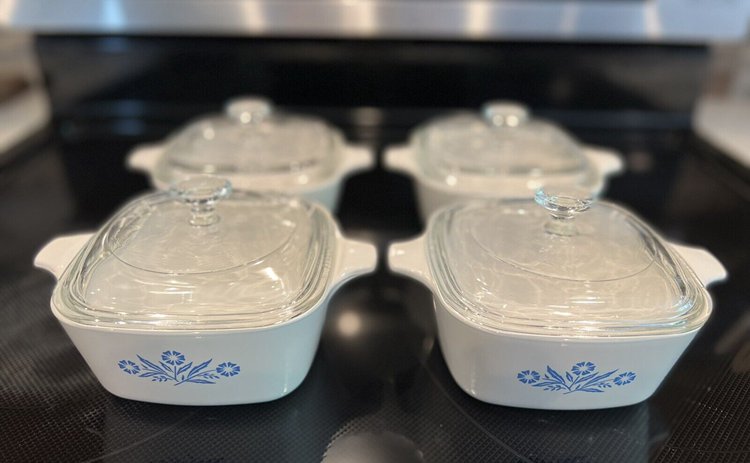
The Cornflower Blue pattern was both the first design to be made available to the public and the one that was manufactured in the greatest amount.
Over the course of more than three decades, this uncomplicated ornament—which consisted of three blue flowers set on a plain white background—served as the identifying motif. The handles were quite modest in size, and the sides of the oldest pieces were slanted.
Blue Cornflower CorningWare patterns, produced in vast quantities, were considered to be the company’s signature design. This pattern immediately became the norm in American kitchens and lasted for more than three decades.
With its classic, time-honored appearance that is derived from the blue-and-white porcelains of yesteryear, this is the design that collectors desire the most.
After 1972, the sides were redesigned to be more vertically aligned, and the handles were made significantly larger. The company celebrated its 60th anniversary by re-releasing its timeless blue cornflower pattern at Bed Bath & Beyond.
In recent years, the blue cornflower design has been brought back into use. It is sold for an inexpensive price, as well as thousands of dollars depending on when it is manufactured.
2. Starburst Pattern Percolator
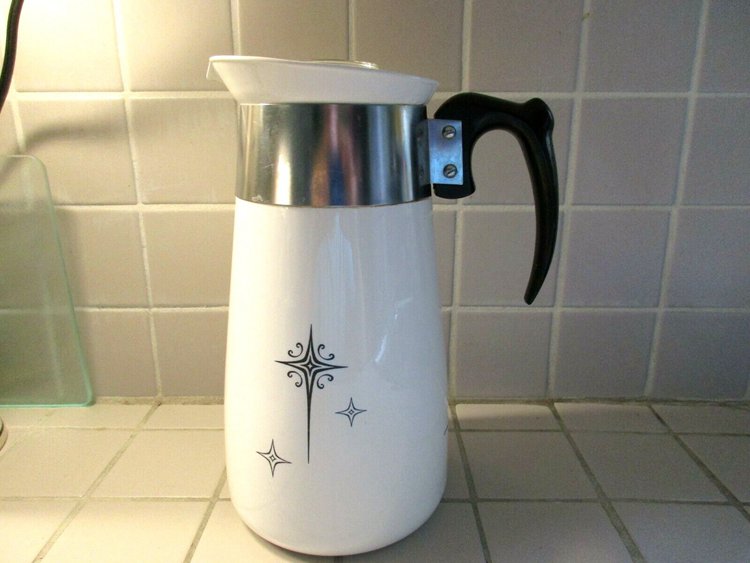
Between the years 1959 and 1963, this design was widely used on coffee percolators. The blue-black variant is widely regarded as one of the valuable Corningware patterns.
CorningWare coffee percolators, regardless of their era, are increasingly hard to find. They were recalled in the late 1970s, and very few of them have survived the event in their whole to this day.
3. Platinum Filigree
Year: 1966 – 1968
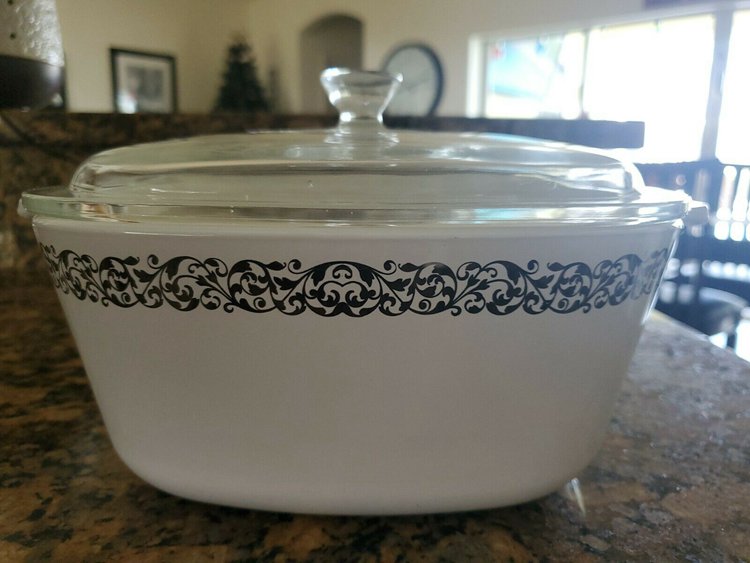
It was a limited edition gift range that was available between 1966 and 1968. This set only had 5 pieces; 2 Saucepans, 2 Electromatic percolators and an Electromatic 4-quart Saucepot.
Despite its intricate design and limited production, it is not a highly valuable collector’s choice.
It was a perfect set to gift as a wedding present. These are rare patterns to find now due to its limited production. You can check out thrift shops and eBay for sellers that might sell it.
4. Renaissance Set
Year: 1970
Price: $100 or more
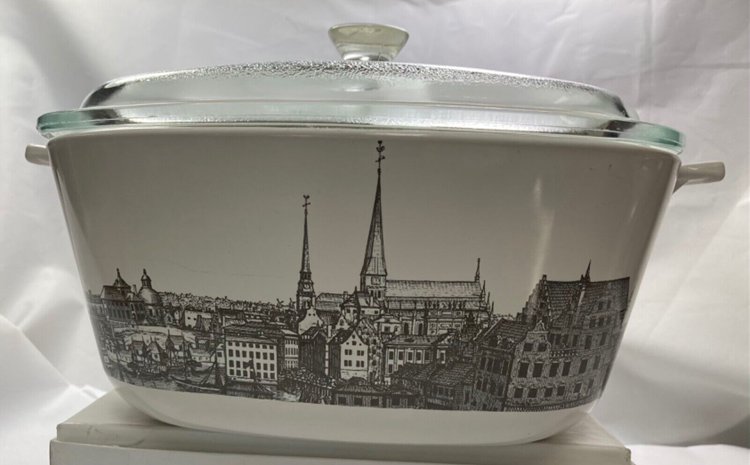
In 1970, Renaissance launched a limited edition gift line. The design is a reproduction of a historic etching that can be found in the book Suecia Antiqua et Hodierna, which was authored by Erik Dahlbergh in the middle of the 17th century.
The etching depicts Stockholm’s harbour with a triumphal arch. Using Miniver Grey as the colour of choice, Corning replicated the etching.
These items can be purchased online for approximately $100 or more. On the other hand, the most desirable 4-QT Renaissance casserole dish that also comes with a trivet ceramic dish holder can be rather expensive.
5. Nature’s Bounty Pattern
Year: 1971
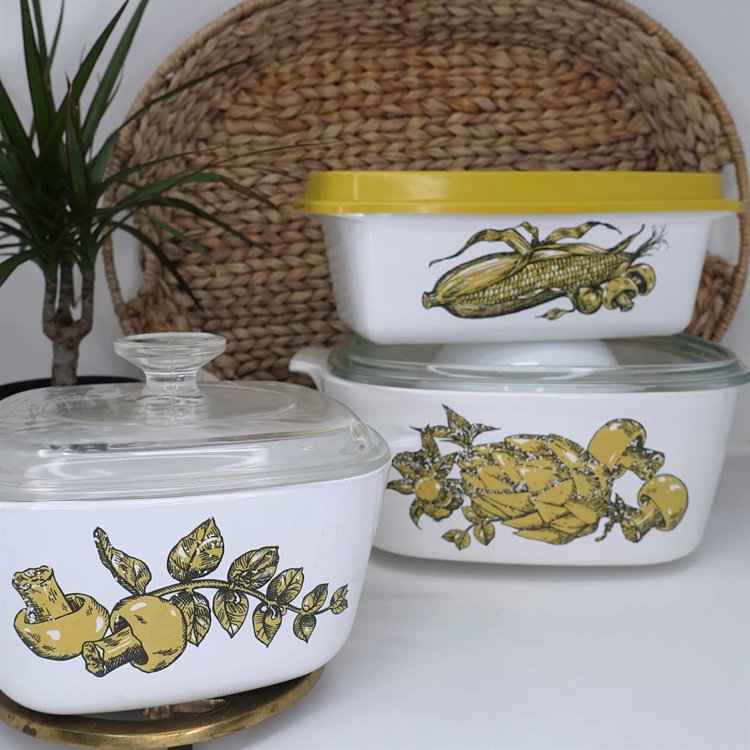
In 1971, Nature’s Bounty debuted as a limited edition gift set. Nature’s Bounty is a dish that is mostly white, topped with veggies that are mustard yellow in color and have a harvest sense to them.
Given that it was produced in a limited amount as a gift series similar to Platinum Filigree and Renaissance, its value is unquestionably higher than that of a typical piece. It is also considered one of the rarest Corningware patterns along with Renaissance pattern and Blue Heather.
Nature’s Bounty is one of those strange patterns that has never really taken off. The hue was a touch-off, and most people didn’t like it because of its unusual appearance which included mushrooms and yellow vegetables.
Therefore, despite the fact that it is hard to find, there are not a lot of individuals who are interested in collecting it.
6. The Medallion Pattern
Year: 1972 – 1974
Price: $40 – $50
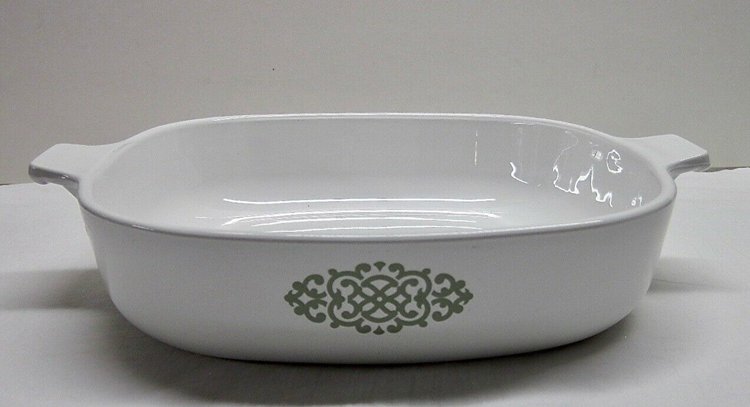
The Medallion pattern is characterized by a combination of artistic lines that come together to make a stunning design. The CorningWare medallion design was offered in both blue and green, depending on the customer’s preference.
One of the most hard-to-find CorningWare patterns in existence today is the Medallion. This is due to the fact that it was designed to be used as a promotional pattern for the Shell Oil Corporation between the years 1972 and 1974.
This indicates that there were just a few dishes created and that, unlike other CorningWares products, they were not offered for retail sale in stores.
The vintage CorningWares with the Medallion pattern can be found today for a price ranging between $30 and $100 on different auction sites like eBay.
7. Spice of Life Collection
Year: 1972-1987
Price: $100 – $10000
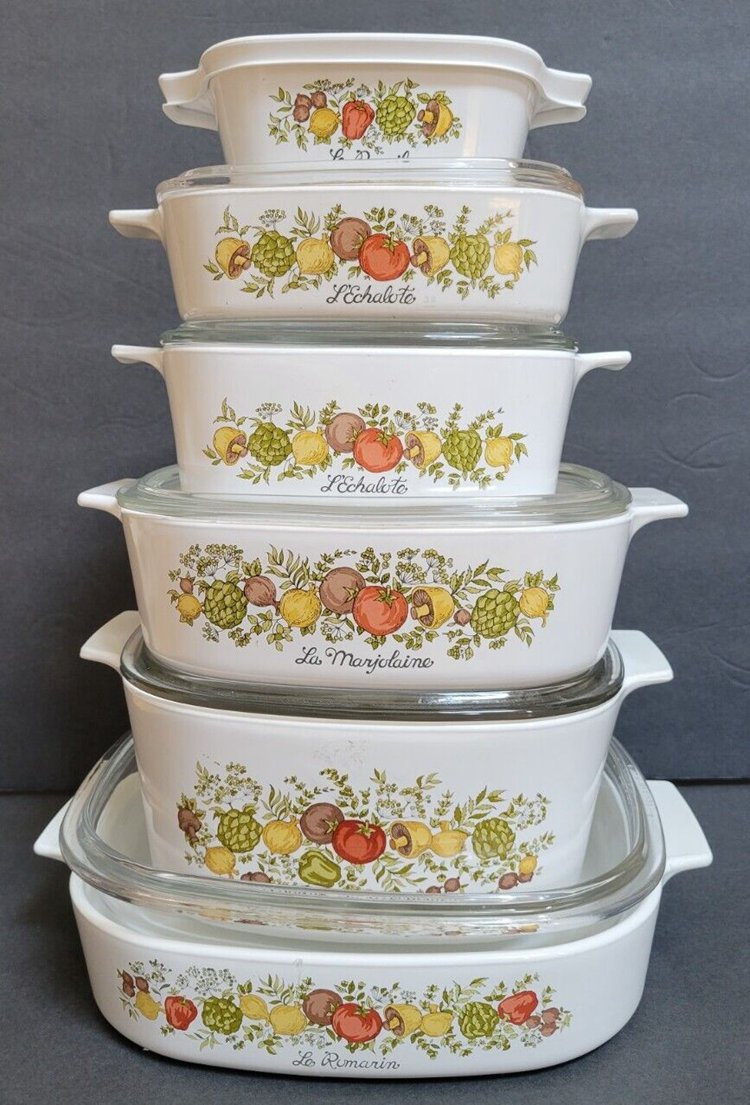
Depending on the size, shape, and seasoning added to the basic motif, this cheery pattern with a transparent Pyrex top was made from 1972 to 1987 in a few forms. In addition to garlic, mushrooms, green peppers, artichokes, and tomatoes, the pattern includes a variety of herbs.
CorningWare’s ‘Spice of Life’ collection is commonly considered to be the company’s second-most popular pattern, right after ‘Cornflowers.’
However, if they are in good condition and still have their original lids, select models within this price range can sell on the internet for thousands of dollars.
The dish’s model name was only inscribed underneath the pattern on the early plates. Rare model names include ‘L’echalote La Marjolaine’ and ‘Le Romarin’.
As a result of their extreme rarity, casserole plates with this pattern that are in perfect condition are sold for thousands of dollars. An eBay seller, for instance, is selling a 4 piece set from 1970 for $20,000.
The thermal shock resistance of these casserole plates makes them safe to use, however they should not be placed near a heat source.
8. Blue Heather
Year: 1976 – 1979
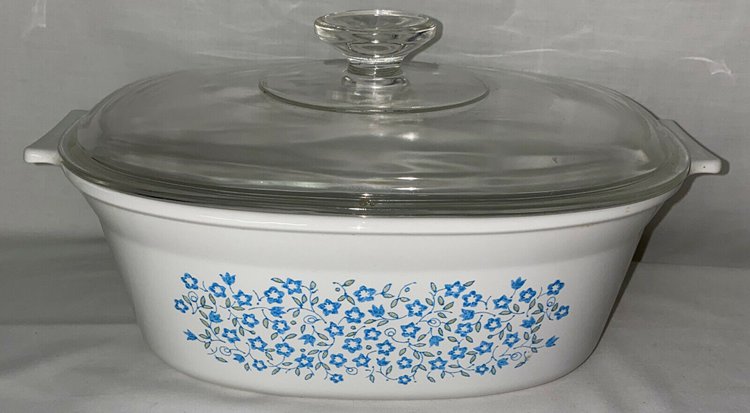
During the middle of the 1970s, the Blue Heather design was only produced for a brief period of time. There are blue blooms with five petals each, and they cover the majority of the edges of the plate. Flowers are connected to one another by means of tiny leaves and vines.
Corning Ware Blue Heather is a hard-to-find pattern as it was only produced for four years- from 1976 to 1979. You can find this pattern at shops like Etsy, and eBay for a reasonable price.
9. Wild Flower
Year: 1977 – 1984
Price: $100 or more
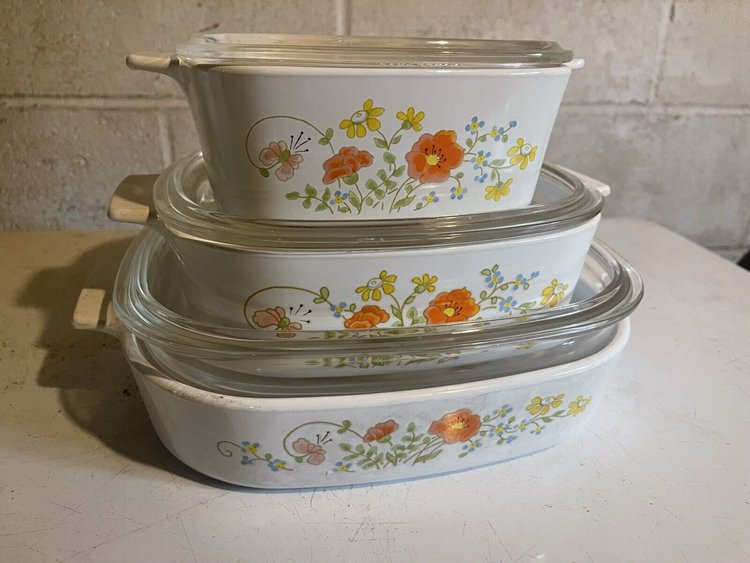
Between the years 1977 and 1985, CorningWare sold their bakeware in the Wildflower pattern.
The vibrant red poppies, delicate blue blooms, sunny yellow daisies, and other wildflowers that are featured in the Wildflower design conjure up images of a day filled with warmth and bright sunshine.
1978 saw the first appearance of the Wild Flower Orange Poppy. This design continued to be produced all the way up to 1984 and included orange with yellow, blue, and green highlights.
Previous CorningWare designs were simpler in comparison to this one’s elaborate floral patterns.
You can find this pattern at shops like Amazon, Etsy, and eBay for a reasonable price approximately $60-80. Nevertheless, there are pricey ones that can be found for between $3,000 and $5,000 as well.
Which Corningware is Valuable?
After learning about different patterns and designs that are considered to be vintage, the question that comes to mind is about vintage Corningware value.
Vintage CorningWare designs are still fairly inexpensive. They can be purchased for a low price and can be found in abundance at second-hand stores, garage sales, and online.
There are hardly many rare collectables that are worth a significant amount of money, but pieces that are harder to locate may sell for a bit higher price. The pieces that have defects or were produced in an incredibly restricted quantity tend to be worth more money.
Even if some of these pieces have sold for hundreds of dollars, this occurrence is still rather rare. For instance, the Black Starburst pattern is thought to be unusual; nonetheless, a percolator with this pattern only recently sold on eBay for approximately $70.
Which Vintage Corningware Is Worth The Most?
Majority of us possess one or two CorningWare dishes but don’t know their worth.
The earliest Blue Cornflower pattern with sloped sides is among the CorningWare pieces that are considered to be among the most expensive. These priceless artifacts are guaranteed to bring in four figures, somewhere in the range of $1000 – $1500 easily.
CorningWare’s “Spice o Life” patterned cookware is another highly desirable piece of the company’s product line. About $1000 and more can be gained from selling them.
What is the Rarest Corningware?
The most collectible Corning Ware is one with the medallion pattern. It is quite challenging to acquire them in this day and age due to the fact that they were not offered for sale at retail outlets.
CorningWare patterns like the Renaissance, Nature Bounty, and All White are also extremely unusual and hard to find for a variety of reasons. Due to the fact that they were limited editions, the Renaissance and the Nature Bounty were only made in restricted quantities at the time.
The Black Atomic Star and the All White were among the patterns whose manufacturing was halted only a few years after it had first begun. As a result, not very many of either design were manufactured at the time.
To find these sets is to find a needle in the haystack. Collectors all over the world search for these designs because of their limited collection.
How Much Is Old Corningware Worth?
With headlines like “Your grandma’s CorningWare could be worth thousands” and “Your vintage CorningWare could be worth up to $10,000,” it would not be shocking to see people wonder how much their CorningWare is worth.
On resale websites like eBay, many collectors have increased the prices they are asking for the CorningWare they are selling to hundreds of dollars due to the current surge in demand.
Nevertheless, only because a price is being asked for an item does not guarantee that it is actually worth that much. According to Insider, these inflated prices of CorningWare on sites like eBay and Etsy are the result of the sudden surge in the hype of vintage CorningWare.
Instead, before you buy or sell CorningWare, you should find out how much each piece is worth by consulting with a kitchenware assessor or looking through postings that have previously been sold.
Whether you have the blue floral pattern or the multi-colored art, the website How To Tell If created a short guide to help owners of Corningware products analyze the potential value of their kitchenware.
Vintage Corningware items may sell for a reasonable amount on eBay, but you shouldn’t expect to make enough money to go on a luxurious vacation.
Beloved by Generations
Vintage CorningWare has been adored by the American family for decades.
Because of their excellent craftsmanship, Corningware cookware has been in continuous use for at least fifty years. While finding the appropriate pattern of Corningware to add to your collection can be a difficult task, it is possible with the right information and equipment.
By now, you should have no trouble spotting vintage Corningware from the modern-day equivalent, as well as understanding the various styles that were produced and the current market worth of each.
You can get in touch with us via comments or email if you still have questions. Your input is always appreciated.

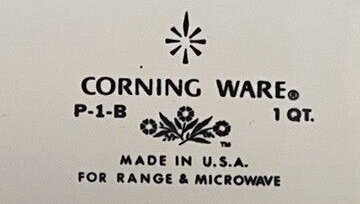




![Where To Sell Antique Furniture In 2022 [Ultimate Guide]](https://www.jacquelinestallone.com/wp-content/uploads/2022/09/Etsy-Your-Place-To-Buy-And-Sell-All-Things-Handmade-600x450.jpg)


